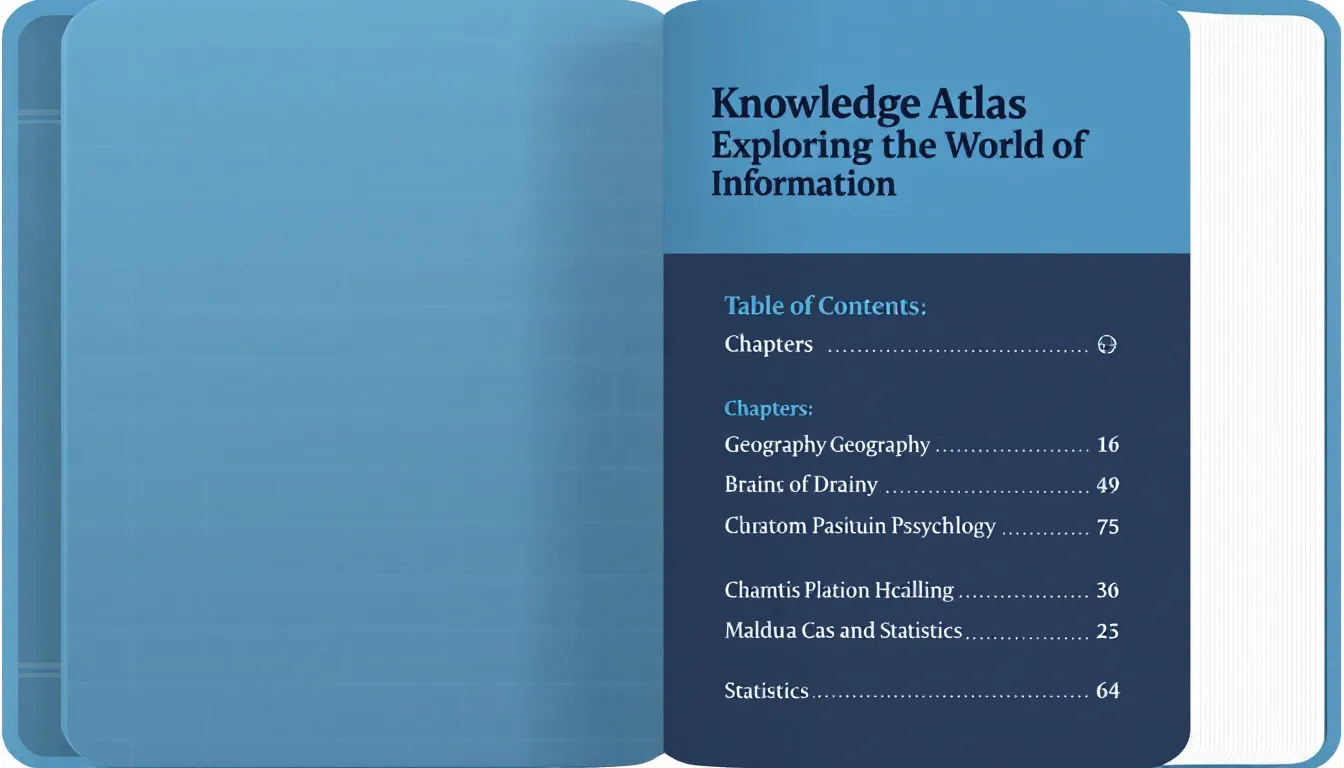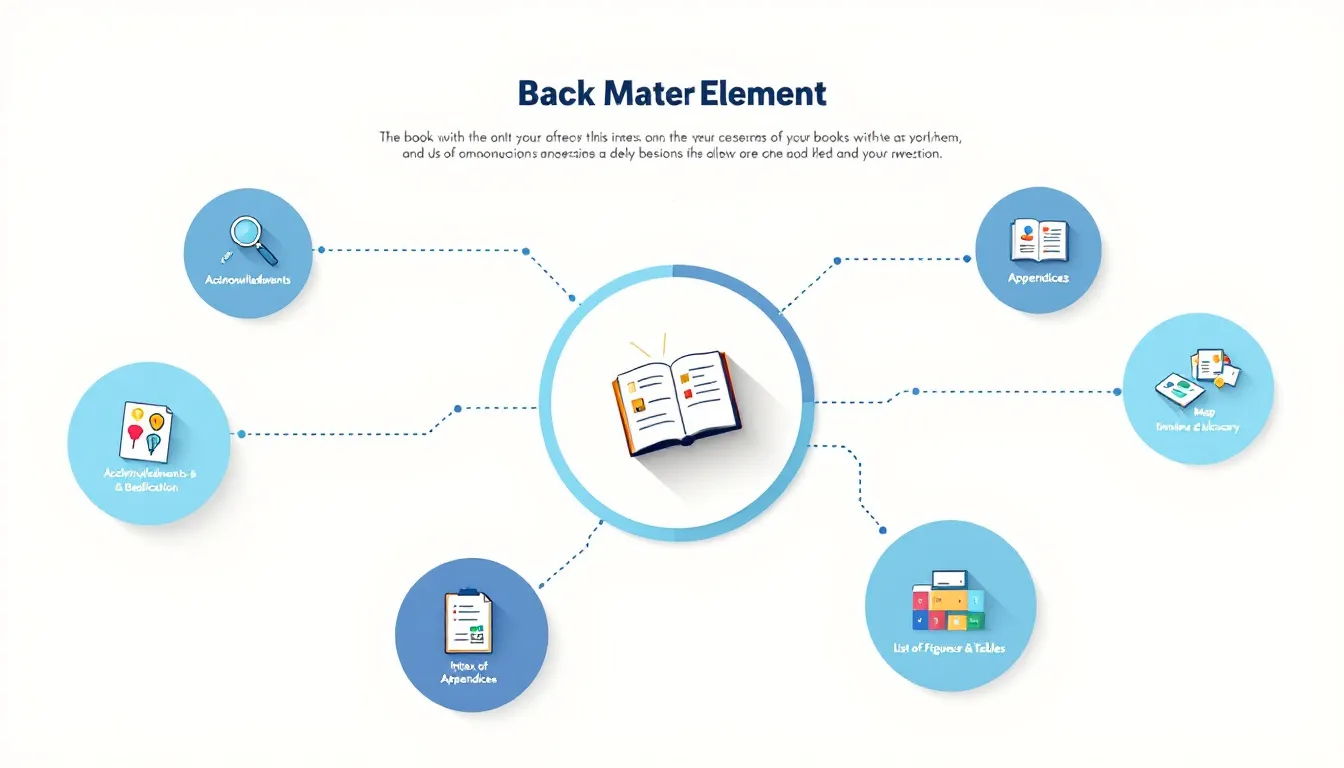Essential Parts of Nonfiction Book: A Comprehensive Guide
May 23, 2025
Essential Parts of Nonfiction Book Explained: Comprehensive Guide for Writers
So what are the essential parts of a nonfiction book? This guide breaks down each component, from front matter to back matter, and explains what they do and how to arrange them.
The table of contents is created after the entire book content is finalized.
Key Points
-
Nonfiction books are all about informing and educating with a clear premise for the intended audience.
-
Front matter elements like the half title page, title page and copyright page set the stage and provide context for the reader.
-
Well structured back matter with a glossary, appendix and index makes the book more usable and supports the reader’s understanding.
-
Providing additional resources like courses can help readers go deeper into the topic after reading the book.
What is Nonfiction
Nonfiction writings are those grounded in fact with the aim to inform or instruct the reader. These are different from fiction books which are born out of imagination. Nonfiction texts stand out for their commitment to truth and play a big role as educational tools by providing clear solutions or insights that fosters personal development and knowledge expansion. Knowing the features of non-fiction writing can make one’s reading journey more enjoyable.
A good nonfiction book is often characterized by its clear premise introduced early on so the reader knows what the book is about and what to expect from it. Tailoring the material to a specific audience—single parents, industry professionals, or enthusiasts—is key. It’s not just to engage the reader but to amplify the work’s impact.
In nonfiction writing, clarity is king—it enables you to convey ideas concisely and enables the reader to understand without complexity. By grounding your narrative in accuracy and veracity, you build trust with your audience and give them reliable information that can be used in practical contexts. You must explain complex concepts clearly so the reader can understand specialized terminology and key principles.
Front Matter Elements
A nonfiction book’s front matter are the pages before the main text which helps acclimate the reader by providing important details and background about the book. This is like an appetizer that whets one’s appetite before the main course, it primes the reader for what’s to come in the main content. In this section, elements like the half title page, full title page and copyright page serve different purposes that guides and legally defines the book from the very beginning. These components helps the reader to understand and navigate through nonfiction works. Front matter pages are usually numbered using roman numerals.
Half Title Page
In the front matter of a nonfiction book, the half title page is an understated but important element. It has only the title of the book and acts as a one-page introduction that primes the reader for what’s to come. Though often overlooked, it’s essential to introduce the title right from the start. The half title page leads into the first chapter, sets the stage for the book.
By showing only the title on this page, known as half-title or simply ‘half title’, anticipation is built and focus is centered—gently preparing the reader for what’s to come while making clear what topics are covered by these titles. This is where their intellectual journey begins.
Title Page
The title page is another important element in the front matter. It has the book’s title, subtitle, author name(s) and publisher details. Placed right after the half title page, it provides the first impression and basic information about the book, and sets the professional tone.
Together the title page and half title page orient the reader about the book’s content and authorship, so they have all the information they need before they dive into the main content.
Copyright Page
The copyright page is an essential part of the front matter, as it provides the necessary legal information. This page has the copyright notice, publisher notice, edition notice and any relevant legal disclaimers. It’s a critical part of protecting the author’s intellectual property.
The copyright date indicates when the work was published, the edition notice specifies any updates or revisions. This note information is important for both legal protection and to inform the reader about the version of the book they are reading.
Table of Contents
The table of contents is a blueprint of the book. It presents its organized structure and makes it easy to access individual chapters. It’s like a navigational tool that helps the reader find specific topics quickly, thus improves their overall reading experience. A well-structured table of contents gives clear indication of what each chapter is about, and makes it easier to browse through sections. By including chapter summaries it helps the reader to grasp the material within each section. Not only does this helps the reader to find the information they need quickly but also sets explicit expectations about what the book covers.
Finalize the table of contents as one of the last stages to ensure it mirrors what’s in the completed chapters, no inconsistencies between the content and the text within those sections.
Main Body

At the heart of any nonfiction book is its main idea, which is the repository of its core content. These works are written with clear and organized text structure to convey factual information effectively. The composition of this section has three main elements: an introduction, several main sections that are usually broken down into chapters and a conclusion—all part of the story in nonfiction.
To explain complex information and to understand, visual tools like graphs, diagrams, photographs and maps are often used in these texts. These visual elements greatly enhance text features by making the data more digestible and more engaging to the reader.
Parts and Chapters
Nonfiction works are thematic, each segment focuses on a particular topic. It’s important that the chapters within these parts follow a theme or show sequential progression to make sense to the reader. This organization makes the book more user-friendly and helps the reader to find what they need quickly.
It’s good to start each chapter with an overview before diving into sub-chapters that provides more detailed guidance. To mark a new section clearly, the first page of each chapter should be visually distinct. This method keeps the reader engaged and makes the content more consumable.
Visual Aids
Nonfiction books often includes visual aids which plays a big role in enriching the understanding and memory of the content. The inclusion of tables, graphs and images helps the reader to understand complex ideas. By interspersing text with these graphical representations they also capture the reader’s attention.Charts and diagrams are very helpful as they break down complex data into more consumable forms for easier understanding and recall. These features are even more important when explaining concepts within specialized books on technical or detailed topics—they help to clarify the material while keeping the reader engaged, by providing information about illustrations and photographs.
Back Matter

The finish of nonfiction books is often attributed to the back matter, which makes them look professional. This section usually includes glossary, appendix and index—each component will help the reader to understand and navigate the content. Indexes are usually found at the end of the book and are very important in helping the reader to navigate the content.
This not only makes the book look good, the back matter also gives the reader the tools to fully understand the content. By being reference points, these elements turns the book into a total resource.
Glossary
For readers who are not familiar with the topic, a glossary is an alphabetical list of key words with their definitions, important terms listed in alphabetical order. It’s like a mini dictionary for those new to the field.
In general, this glossary provides short explanations for key terms and often provides page numbers for reference which helps the reader to find and understand the terms used in the text.
Appendix
The appendix contains supplementary material or information related to the topic which may include examples, maps or additional data. Not all nonfiction books have an appendix but those that do find it useful in understanding.
By adding extra materials in the appendix the reader’s understanding of the topic is enriched with extra resources that supports the main text.
Index
Most indexes in books are several pages long, an alphabetical list that encapsulates all the topics in the book, so the reader can find specific information by alphabetical order. This organized system includes page numbers which makes it easy to find various subjects and annotations across the text.
For those who are doing research and reference work, an efficient index is essential as it helps the user to move through the content easily. It’s an important tool to pinpoint and retrieve information and therefore makes the book more accessible and useful.
Book Cover
A book cover is an important part of a nonfiction book as it’s the first thing readers see. A professional book cover designer with experience in nonfiction can create a cover that stands out. The front cover should have the title, subtitle, author name and an image or design. The back cover should have a brief summary of the book, testimonials and reviews. The book spine should have the title and author name so it’s easy to find on a bookshelf. A well designed book cover can make a big difference in the success of a nonfiction book.
Book’s Promise
The book’s promise is the main idea or message the author wants to convey to the reader. It’s the main takeaway the reader should get from the book. The promise should be clear, concise and relevant to the target audience. It should be stated in the introduction and reinforced throughout the book. The book’s promise is what sets it apart from other nonfiction books and makes it unique. It’s the author’s guarantee that the reader will get valuable insights, knowledge or skills from the book. A well crafted book’s promise can engage the reader and keep them interested in the content.
Outcome Benefits
Outcome benefits are the specific results or outcomes the reader can get from reading the book. They should be clear and measurable, providing direction and purpose for the reader. Outcome benefits can be gaining new knowledge, developing new skills or solving a specific problem. They should be relevant to the book’s promise and the target audience. By providing outcome benefits the author can help the reader to understand the value and relevance of the book and stay motivated and engaged throughout the reading process. Outcome benefits can also be used to market and promote the book, highlighting its unique value proposition.
Writing Style and Tone
The writing style and tone of a nonfiction book is critical to engage and keep the reader interested. The tone should be informative yet conversational and approachable. The writing style should be clear, concise and easy to understand, avoiding jargon and technical terms that may be unknown to the target audience. The author’s voice and personality should shine through making the book feel more personal and relatable. The tone should be consistent throughout the book creating a sense of continuity and flow. A well written nonfiction book should be engaging, informative and easy to read, a valuable resource for the reader.
Tips for Writing Nonfiction Books

Writing a nonfiction book involves meticulous preparation and organization to ensure the content is both interesting and educational. Having a detailed table of contents before you start writing can help you progress efficiently by providing a framework. Guidance for writing a nonfiction book includes focusing on articulating a clear concept, keeping structure uniform and reinforcing arguments. It’s also important to define the book’s focus and reader promise before you start writing to ensure clarity and direction.
Following this advice allows writers to produce not only readable but also influential nonfiction that delivers their message clearly through written lessons. For any writer aiming to write a nonfiction piece, it’s crucial to prioritise coherence and reader engagement throughout their creation.
Clear Premise
Stating the book’s central promise and main focus upfront ensures readers get it quickly. It’s important to establish this understanding early so readers know what to expect from the book. Most books have certain elements that need to be aware of.
To ensure the premise is understood, the writing style should be simple and accessible. By keeping your message clear and articulating a solid premise you engage your audience and deliver your ideas successfully.
Consistent Structure
Presenting information in a clear and logical way is crucial for the reader’s understanding. The foundation of the book dictates its structure, so readers can navigate through complex details with ease, as the organization of thoughts must be presented in a way that makes sense to the reader. By having someone review each chapter, any confusing sections can be identified and any explanation can be made clear throughout. This is the basis of good communication and makes sense.
Supporting Statements
Using supporting statements and notes in nonfiction writing adds credibility to an author’s claims and makes their work more trustworthy.
Mixing personal anecdotes with professional views not only strengthens an argument but also makes nonfiction writing in our world make sense to readers. This makes the content more believable and reliable.
Editing and Revisions
Editing and revisions are part of the writing process of a nonfiction book. They help refine the content, clarify the message and ensure the book is error free and polished. The author should review and revise the manuscript multiple times to ensure the content is accurate, up-to-date and relevant to the target audience. A professional editor can also be hired to review the manuscript and provide feedback and suggestions for improvement. Editing and revisions can be time consuming but it’s critical to produce a high quality nonfiction book that engages and informs the reader. By investing time and effort into editing and revisions the author can ensure the book meets the highest standards of quality and accuracy.
Conclusion
Understanding the elements of a non fiction book is key to writing a piece that captivates and educates. Clarity and organization is crucial for reader comprehension and engagement. Each section from the front matter to the back matter contributes to giving the reader a seamless and comprehensive experience.
Following these guidelines allows you to write well structured nonfiction. So take this on board as you start creating your own nonfiction book—armed with confidence in its success.
FAQs
What are the 4 elements of non fiction?
The 4 main elements of nonfiction are layout, information, characterization and style/tone. These elements bring true stories to life, making them engaging and relatable.
What are the 5 R’s of creative nonfiction?
The 5 R’s of creative nonfiction are real life, reflection, research, reading and writing.
These elements keep your writing grounded and engaging, your real life stories come alive!
What is the purpose of the front matter in a nonfiction book?
The front matter of a nonfiction book helps you get oriented by giving you important info and context before you get into the main content. It’s like the table of contents!
Why is a clear premise important in nonfiction?
A clear premise is important because it introduces what your nonfiction book is about, so readers know what to expect.
It keeps them engaged and on track from the start.
What’s in the back matter of a nonfiction book?
You’ll find a glossary, appendix and index in the back of a nonfiction book. These help explain terms and make it easy to find specific topics, so your reading is smoother.
Stuck Knowing How to Publish Your Book?
Take the quiz to Discover the Ideal Book Publishing Path for You


